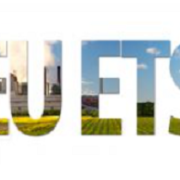Can the inclusion of nutrient recovery in the EU ETS scheme support its growth?
Five large biogas plants participating in SYSTEMIC[1], have installed and successfully demonstrated anaerobic digestion with full scale technical nutrient recovery and recycling. Several digestate derived N fertilisers show nutrient use efficiencies equivalent to synthetic N fertilisers and are compliant with proposed “RENURE[2]” (“REcovered Nitrogen from manure”) criteria – for animal by-product-derived fertilising products. However, revenues from sales of recovered nutrients are not yet covering the digestate treatment costs as described in the Business Case Evaluation Report. Additional incentives are needed if the sector is to become financially viable
Incentives should be value based. The EU Emission Trading System (ETS) correctly assigns a cost to greenhouse gas emissions (EUA Futures) and consequently a value to avoided emissions. Recovering and recycling high efficiency fertilising products from digestate avoids emissions from producing synthetic fertilisers, but biogas plants are not covered by the system. They cannot benefit from avoiding emissions. Since farmers are typically not willing to pay more for highly efficient plant nutrition products than for untreated manure, the additional efforts remain unpaid.
The transition to a net-zero emission economy requires that all actors reduce emissions, farms need to become carbon sequesters instead of carbon emitters. The question is, how can policies create a just framework in which every saved CO2-equivalent is financially rewarded?
In theory, fertilising product manufacturers who are already covered by the system would save CO2-certificates, equivalent to 3-4 tons CO2eq per ton of N representing a current EUA value of € 150-200 per ton of N if they buy and distribute recycled fertilisers. In practice, this would need a certification and clearance body similar to those currently underway for bio-methane, hence additional legislation. Maybe some provisions are foreseen in the updated ETS rules expected for July 2021. However, a system by which biogas plants would be directly compensated if they sell their products locally, directly to farmers or through intermediaries, is not yet on the horizon.
Using untreated biowaste or manure on farmland is typically associated with high greenhouse gas emissions and high nutrient losses to air, water and soil due to low nutrient use efficiencies. The real contribution to global warming is, however, controversially discussed and more research is needed to draw a baseline. The emissions of industrial fertiliser producers have been assessed and are well known. SYSTEMIC plants typically use power and heat from their own conversion processes and products from the market with well-known greenhouse impacts. In some cases, by-products / waste (e.g. REA-gypsum) is used for producing mineral N-fertilisers (ammonium sulphate). Products and processes need to be assessed for their environmental and climate impacts before their real value in terms of CO2-emission savings is determined.
If the EU is to achieve net-zero emissions by 2050, biogas plants producing recovered and recycled nutrients could make a substantial contribution to this goal. Farmers can contribute by avoiding high emission farming practices and fertilisers. At the same time, businesses and farmers that contribute must be fairly rewarded. Convincing strategies are only the beginning of the transition to a circular, climate neutral economy.
[1] SYSTEMIC – Circular Solutions for Biowaste, https://systemicproject.eu/
[2] JRC Publication “Technical proposals for the safe use of processed manure above the threshold established for Nitrate Vulnerable Zones by the Nitrates Directive (91/676/EEC)” https://publications.jrc.ec.europa.eu/repository/handle/JRC121636




